This is the first in a series of interviews with seasoned bikepackers from all over the world. Pepper Cook is a Salsa Cycles rider, EMT (emergency medical technician), founder of the Worldwide Spoon Exchange, and all-round legend based in Alaska. I’ve been fortunate to spend time with her in Iceland and lucky enough to call her a friend. She’s a rider that has always inspired me, and the opportunity to speak with her at length was a real privilege. Her infectious love of adventure and can-do attitude in the face of adversity is awe-inspiring. She’s a gentle, humble, and kind individual who, despite her wild life story, shared struggles and experiences that we can all relate to. If you’re a seasoned bikepacker, a first-timer, or simply in need of an uplifting read, this is for you. Thanks, Pepper, for your time, wisdom, and poop stories.

I think it’s safe to say that your life has been one big adventure. Where did it all start? How did you come to live in Alaska?
I was born in Denver, Colorado, but my mum’s from New Zealand, so I have two passports. Right after university, I realised I could do the same retail/bike shop work in New Zealand for a higher wage and also be in, well, New Zealand! I was there for about a year, then travelled down to South Africa and lived in Cape Town for around the same length of time. I meant to go back to my bar management job in New Zealand, but I ended up getting off on a layover in Australia because I realised you don’t need a visa to live there if you have a New Zealand passport. That was a long layover, six years! I rode all the longer bikepacking routes that were accessible to me in Australia, around the same time as the Baja Divide, Great Divide, and other US routes were getting popular, and it made me want to move back. I started with the Baja Divide, but at the end of that, Covid kicked off, and I got a job offer from my friend Christina Grande, who’s active in the bikepacking scene, and lives in Alaska. She said there was a bike shop there often hiring, and she’d help me find someplace to live. So, Alaska got handed to me on this golden plate!
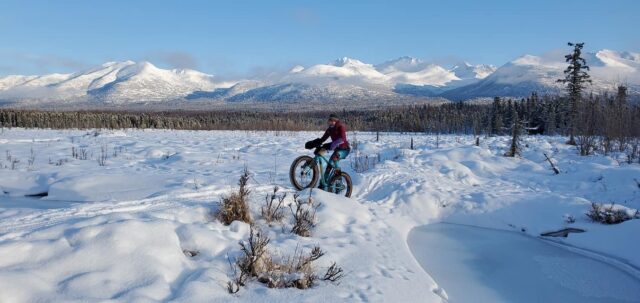
Alaska has a reputation as one of the most rugged and beautiful places on earth. What’s it like to live there? Is Alaska somewhere you could call home long-term?
I’ve lived in a lot of places and experienced lots of mountains during different seasons, but Alaska is somewhere that sinks its hooks into you. The season change is drastic; every day, you’re either gaining or losing minutes of daylight, depending on the time of year. The seasons are whipping by before your eyes, and in the summer, there’s almost 24 hours of daylight, so you can mountain bike, fly fish, or anything for 16 hours per day. And in the winter, you can backcountry ski or fat bike. I meant to come here for three months, then I was going to check out Montana, and ended up staying here a year and a half already. I mean, you can ride to glaciers; there are bears in town; my window was blocked by moose the other day. It’s how you’d imagine, like the movies!

How did your love of cycling, and subsequently, bicycle touring come about?
When I was in high school, I got a touring bike at a garage sale, and that was my first vehicle of freedom. I didn’t have a car license yet, so I rode the heck out of that. Then when I got to college in Boulder [Colorado], I realised I could ride to the next town and meet a friend for drinks, then get a bus back. So, after those longer day rides, 80 or 100 miles, I figured I could go even further with a tent. That started a love of overnighters.
I then moved to Australia, and that’s where it really blew up for me. The first place I stayed was in Brisbane, where you can ride from the inner city to a ferry that takes you to a beautiful island. I was able to go camp on a beach for the weekend and then ride back before work on Monday. Then it branched into weekend trips, and I started wondering if I could ride from Brisbane to Melbourne, which I did with zero training or planning. I didn’t even have proper camping stuff, and I gave away most of the things I was carrying during the ride because I was like, “why the heck did I bring all this stuff.” Two hardback fiction books, a kitchen fry pan, and floppy sun hat. I rode for 30 days, Brisbane to Melbourne, then wanted to go farther, so I rode around Tasmania. I didn’t get a single flat tire. My mum said, “Oh, one day, you’ll write a book.” And I was like, and say what? “Hello, my name’s Pepper, I woke up, rode my bike, went to bed, and nothing went wrong.” That planted the seed to then box up my bike and go overseas, and that’s when I met you in Iceland. That was challenging, but at the end of the ride, I realised travelling with your bike and gear was doable. Planning is the scariest part, but when you get there, you know how to ride a bike, and you’re basically just going on a bike ride every day.

Can you tell me about your first extended bike tour and some of the lessons you returned home with?
The main lesson from Iceland was that I wish I’d planned a little better around food because it was so expensive. I wish I’d have thought things through on the exchange rate, looked more closely at resupply points, and brought along cheap/lightweight calories, like a massive bag of couscous. I learnt the hard way on that trip not to eat a whole bag of dehydrated fruit while listening to This American Life podcast. I spaced out, ate a tonne of dried apples and prunes, woke up in the middle of the night 10 feet from the main road, still broad daylight outside, jumped out of my tent barely in time to s**t myself for almost an hour in front of like a million tourists driving by. After Iceland, I avoid wind because that place was so horrifically windy. I’ll ride in any conditions, but not wind like that.
In Iceland, you were riding a more traditional drop-bar touring bike. Did Iceland inspire the transition to an all-terrain bikepacking rig?
No, I’d never heard of many people dirt touring; most of my friends at the time were road tourers. When I got back from Iceland, I was in peak shape because I’d ridden all day for thirty days in crazy weather. I got back to Australia, and the bike shop I’d been working at had gone out of business whilst I was away. Then I found out that the couple I shared an apartment with had broken up in my absence, and they’d terminated the lease. They’d put all my stuff in a friend’s garage. I had no job, nowhere to live—it was a real shock, I was sleeping on my friend’s couch.
At that time, I was contacted by Tumbleweed Bikes, and they were like: “Hey, we just had a rider drop out of this film, we can’t pay you or pay your way, but if you can get here, you can be in a mountain bike documentary, and we’ll let you ride this cool bike.” I scrounged up the money, [with help from] lots of friends and family. I had a wager that I’d cut a mullet and donate the rest to a Locks of Love charity organisation if I could scrape up the money to get the ticket together. I didn’t know anything about the route or the bike. They said, “Oh, it’s got this thing called a frame bag, and the rest of the bags are up to you.” I literally bought luggage I thought would strap to a mountain bike at the thrift store. I made it to Peru, set eyes on the bike, and [thought] ‘This thing is like an apocalypse rig that could ride across the moon.’ After that, I never went on another road tour again.

I enjoyed following your Peru Divide trip and the film that followed (linked below). It looked to be as beautiful as it was brutal. Can you tell us about the ride objectives and share a little more about the overall experience?
The trip over to Peru was a 17-hour flight. I got everything together so fast I didn’t have time to think about the ride itself. But during the flight, I got an email from my mum saying, ‘You’re telling me that three strange men from the internet emailed who you’ve never met, told you to buy a flight to Peru, and you’re going to spend every day and night for five weeks with them.’ I was like, oh crap. Then she said, ‘And they’re going to put you in a movie; you’re going to get scammed! Someone’s going to steal your kidneys!’ I really didn’t think it through at all.
I landed in the airport, and then right off the bat met Jay Ritchey (Instagram: bagsxbird); he was shy and gentlemanly. We waited in a hostel for the other guys and ended up going out for some beers and ceviche. Then I met Cass Gilbert (Instagram: whileoutriding) and Daniel (Instagram: tumbleweedbikes). Cass immediately gave Dan and Jay such a hard time and joked with everybody. Then I found out who they were, and they showed me the bike. I’d never seen a Rohloff hub before! We acclimated pretty rough, staying in a hostel on the third floor, dragging the bikes upstairs to build them; at 20,000 feet, it was brutal. I was shocked I was getting altitude sickness after being born in Colorado.
The rest of the trip, bar the last three days, was smooth sailing—beautiful gravel roads, some long passes, climbs, and descents. There was one climb that took two days, and we got snowed on. I was in shorts and a tee as I didn’t know the route, and we hadn’t had time to discuss what I should bring. On the way down, we descended for a whole afternoon. When we stopped for lunch, I leaned the bike against me, and the rotor was so hot it burned a hole through my pants. The trip was incredible; the guys were perfect gentlemen. The Tumbleweed bike didn’t have a single mechanical.
The last four days were in the Ancash, a crazy hike-a-biking section that was the most memorable and hardest part of the trip. I don’t remember riding that much, just pushing on super steep trails, often over scree fields. Jay fell off a cliff and bruised his ribs badly. I got hemorrhoids from carrying the loaded bike over so many brutal sections.
All-in-all, I was just lucky they found me, that the other person cancelled. It was also fortunate that I’d just finished a huge trip, so I was super bike fit. Afterwards, Tumbleweed asked me to be an ambassador, so again, I was fortunate to be introduced to that bike and take it back to the shop in Australia. I think they’re a big dealer of Tumbleweed Bikes these days. The whole thing was like a weird dream, I had imposter syndrome the entire time; I felt like this goofy road touring nerd who somehow got thrown in with Cass Gilbert, Jay Ritchey, and Daniel from Tumbleweed Bikes.
When I got back, I had to face real life again and try to locate an apartment and another job. I managed to find a good position at a cool bike touring shop. I feel like every trip raises the difficulty level. Every time I finish, I think, “Whoa, that’s the hardest trip I’ve ever been on,” then it escalates. The Baja Divide was harder than the Peru divide, and I figured Baja would be hard to beat. Then this year, I got frostbite and had to walk myself out of the Alaskan wilderness, and now that’s my hardest trip. I had the worst mechanicals; stuff failed in -30°F that I’d never have thought of. Every rubber seal cracked, pedal bearings froze, every non-Salsa part I spent a bunch of money on to ‘pimp my ride’ s**t itself.
I meant to ask about that. Was the frostbite experience scary?
Weirdly not, just painful. I was so intimidated by doing a solo 100-mile winter fat bike ride in Alaska, in temperatures I’d never experienced, that I was way over-prepared. At no point was I cold, hungry, or thirsty, and [thought I] had prepared for every eventuality.
The pedal bearing seized and sheared out the threading on my crank arm; I was 30 miles out. I ended up walking back after trying everything to pedal it. I even used it as a scooter with the remaining pedal. I had several mechanical issues, like tubeless failures because of the cold. I was fiddling with stuff, taking my glove off for a second [at a time]; it didn’t hurt, it just went numb straight away. That was my first mistake; I should’ve left a layer on my hands. A day later, I got blisters, and I still can’t feel my fingertips today. I’m now an EMT, and there are lots of little plastic packets I have to rip open—it’s hilarious; my hands are useless. My feet got huge holes in the back due to over-boots on top of my regular boots. The friction of all those layers burnt these bloody holes in the back of my heels, and I still have big purple scars. Now that was my hardest ride.
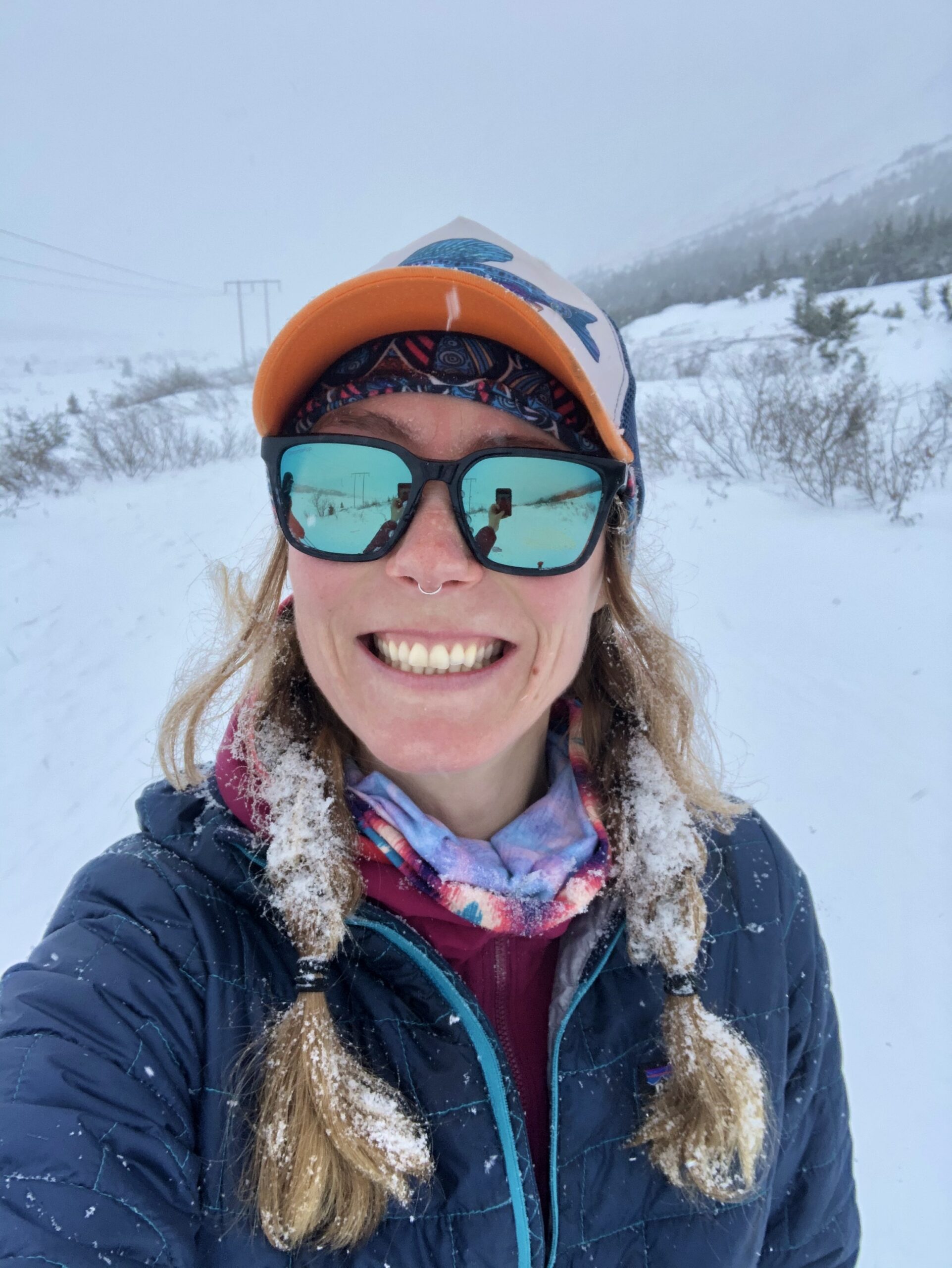
Hard Question. Favourite bike/bikes and why?
Right now, I have an awesome Salsa Mukluk carbon fat bike, which is so cool. I love it so much; it honestly rides like a regular mountain bike in the summer. I have to say, my all-time favourite is the Salsa Fargo. That Fargo is like three bikes in one: I can ride to the grocery store, but it was also the bike I rode on the Baja Divide. It’s a drop bar mountain bike, fits 3-inch tires, it’s got mechanical disc brakes, so I can fix it in two seconds with a pair of pliers and an Allen key. It’s steel with a carbon fork, and the geometry is an exact fit for me.
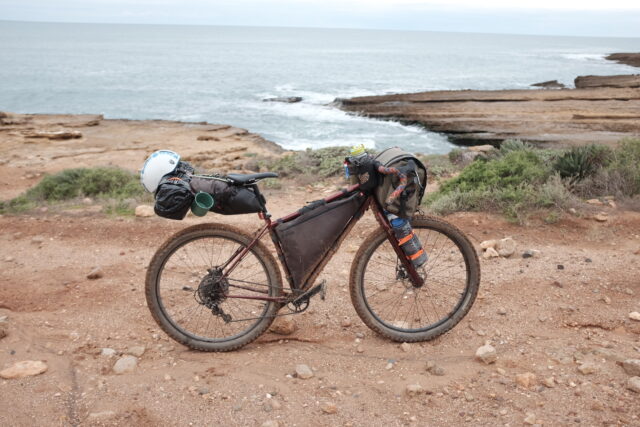
Similarly, favourite bikepacking bags?
I’m always a little broke, so I tend to strap up a lot of gear with voile straps. I also break a lot of stuff. The one thing I’ve not been able to break, which I’m obsessed with, is my Ultraromance Fabio Chest. Oh man, I’ve abused it. At one point, before I got my first car, it was my grocery bag. I’d have the whole thing unbuckled with things spilling out of the top, like a wheelbarrow—I could barely steer it home. I’ve had it for a few years, none of the Velcro is worn, and it’s actually a challenge to remove from the bike. It holds so much stuff and has a plastic insert which keeps it shaped and makes it easy to pack. It’s got so many layers of canvas that it’s really water-resistant, almost waterproof. I’ve hosed it out a few times.

What are your “essential” items for a bikepacking trip?
I like taking a tiny watercolour set. I learned in Alaska that if you put a few drops of vodka inside the paintbrush, it stops the water from freezing. I also enjoy having any brand of blow-up pillow. A lot of my friends sleep on a rolled-up flannel shirt, and that used to be me. Then I got an inflatable pillow at a secondhand shop and thought, ‘that would be fun for a glamping weekend.’ But it packs down to the size of a fist, and you sleep so much better, so now I always bring it. It keeps your head warmer and is fun to lounge on at camp. I love my Six Moons Designs tarp cross pole tent. It weighs around a pound with inner/outer/poles, and often I’ll take the outer only; it packs so small, yet is a huge two-person shelter. It’s cheap too, approximately $300. And if I break anything, they’re super helpful.
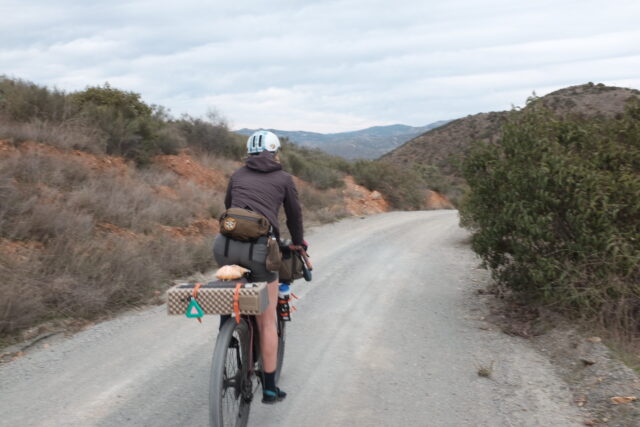
Top tips for someone considering bicycle touring/bikepacking for their next adventure?
I’d recommend getting a bike that fits well. If you’ve not done much touring, choose one with an upright seating position, ensure you have the correct length stem and know how to adjust the saddle. If you’re trail riding with a bike that’s fully loaded for the first time, I’d recommend some flat bars—mountain bike style. They’re easier to pack things on, and you’re going to be able to control it better if you’ve not ridden a lot of rough terrain.
Pack a basic first-aid kit, at the very least some bandages and alcohol gel. On the trail, it’s a lot less predictable than the road, and if you hit a rock the wrong way, or you’re tired, or a dog runs out, you can easily get injured. Get out and try an overnighter; anyone can do it. I remember when I was being asked about my mountain bike experience for Peru, and I hadn’t ridden that type of bike since college, 10 years. I figured, ‘Fake it til you make it.’ I wondered whether I’d be able to ride over a rock garden with a fully loaded rig. You just have to get out there. Perhaps add a little singletrack to your weekend ride. Also, practise riding with all your gear to get a feel of the bike over obstacles or small drops with the added weight.

Bikepacking plans for the future?
Mongolia is a bucket list trip, but Covid makes big international plans difficult. As an EMT, I’ve spoken to a lot of people that got stranded abroad; one guy got stuck in South Africa for six months, burned through his savings, was scared to go out, had no friends or family. So, I’m wary of any big trips right now and being sick somewhere without being able to access healthcare.
The next one I’ve planned is the Idaho Hot Springs Trail: a 600-mile singletrack loop in Idaho, with amazing fly fishing and 50 hot springs. It starts in Boise, Idaho, riding from the airport via all the breweries. It’s logistically pretty easy but remote and challenging enough where it’s not a snooze. I’m hoping I’ll be able to go on that trip in fall.

You’re legendary for many things, but perhaps most notably your skills as a pun wizard. When did the puns start?
I’m ashamed I’ve not gotten any into this interview, but after my night shift, I have no sauce left. I got my degree in English literature, so it’s always been this joke in my family that I went to school but never used it. In South Africa, there are 11 major languages in Cape Town alone. There’s a lot of wordplay, fun mixing of languages to make a rhyme, funny word, or joke. I love playing with language, and it’s my funny way of being like, “See, I told you I’d use my English lit degree for something.” Once you start using puns, your brain is trained to look for them, and now I’m completely wired; it’s a compulsion. It annoys the hell out of the people I work with because if I see one coming, I can’t resist. Patients will accidentally say one, or I’ll drop one into our conversation. If you can make someone laugh, even if they’re seriously ill or have immense trauma, it can make the difference.
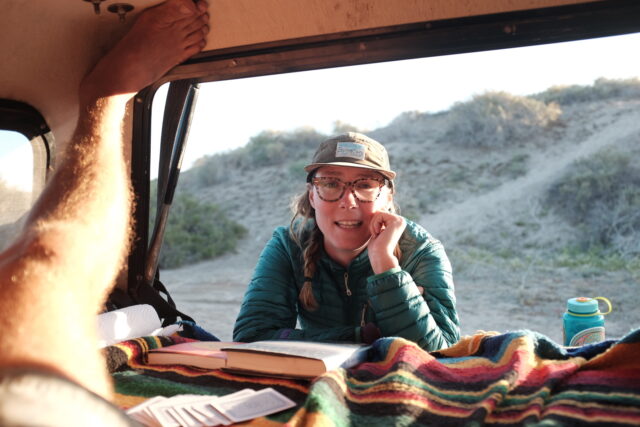
Can you tell us about the Worldwide Spoon Exchange?
My heart is a little sad regarding that question because with the last few months of EMT stuff, I’ve not been able to even touch my spoon tools, and I’ve not been able to run one. It got mentioned on a few bikepacking sites, and I know people are waiting for the next exchange, and I will do one eventually. I saw an article a few years ago about this old guy who makes wooden spoons, paints the handles pretty, then hides them on the Appalachian Trail for hikers to find; he’s a spoon trail angel. I thought it was super cool; the spoons were magical, and I wondered if I could do that. I carved my first one with kitchen knives and sandpaper, and within half a day, I had a really nice spoon.
I went on my Instagram, which wasn’t hugely popular at the time, and posted if anyone wanted to carve a spoon, send me their address, I’ll mix them up, and we can all send one to each other. I thought maybe 10 people would want to do it. The next day I had 220 addresses from all over the world. It was so hard to organise, just chaos. I learnt a lot from that first exchange, and I think we’re in our sixth exchange now. Lots of first-timers, but also experienced wood-carvers. You either get this whacky piece of art from a beginner or some beautiful Swedish-style spoon from an old-timer. Now there are several hundred [people] involved, and I try to ensure that everyone receives a spoon from a different country. One of the secret reasons I started it, in the beginning, is that everybody who follows my main Instagram page is into bikepacking. So, you just got someone from another country that you could possibly bikepack/stay with one day. People send these beautiful handwritten letters, with stickers and patches, and information about the wood. I had a 9-year-old kid from India in the second exchange; he sent his favourite Pokémon cards, and it was the first spoon he’d ever made.
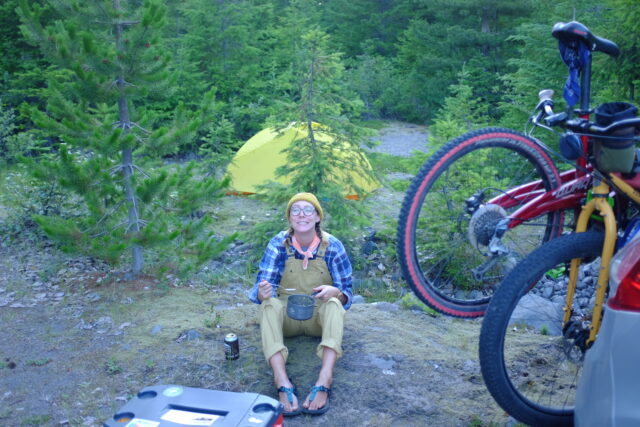
Let’s time travel. If you could meet up with yourself at the start of your journey, what advice would you give?
At high and middle school, I had a lot of pretty bad family stuff go down. My mum struggled with drugs and alcohol, and as a result, we weren’t allowed contact with her for a few years. We didn’t have that much of a relationship with our dad. In high school, I definitely didn’t think I would go anywhere. I hadn’t discovered bikes and didn’t have any idea what I wanted to do with my life. I often wish I could go back in time and meet 16-year-old me and be like, “Stop being a grumpy ar****le and taking drugs with your friends.” I got straight As, graduated early, and went to university, so it wasn’t a total loss, but I was a glass half empty, with no real family, connections, or path in life. I [thought] I’ll just go with the flow and not worry too much because nothing’s ever going to happen for me if all this stuff has already gone wrong. I wish I could go back in a time machine and say, ‘By the time you’re 31, you’ll be an EMT in Alaska, riding for a bicycle company, [and you’ll] have lived in Australia, Africa, ridden in Iceland, Peru, and Mexico.’
In my twenties, I had the best time partying and riding all over the world, but I never thought about tomorrow. I never figured riding a bike could be a way of helping people. I wish I could inject a little more meaning into those early adventures. If you work super hard and say yes to the things that come your way, you can end up in the most amazing places.
I just want to add that my mum has hit 13 years of sobriety, gotten a degree in social work, and is now helping other women get sober. She’s in her mid-60s, yet went back to school and got her masters. She also got a climbing gym membership and worked her way up to climbing 5.10s! I used to think that my life was so directionless. Then I looked at my mum; she’s been in jail and lived in homeless shelters, but one day she [decided to change her life]. I’m in my thirties, and realised If I don’t like something, I can change it.
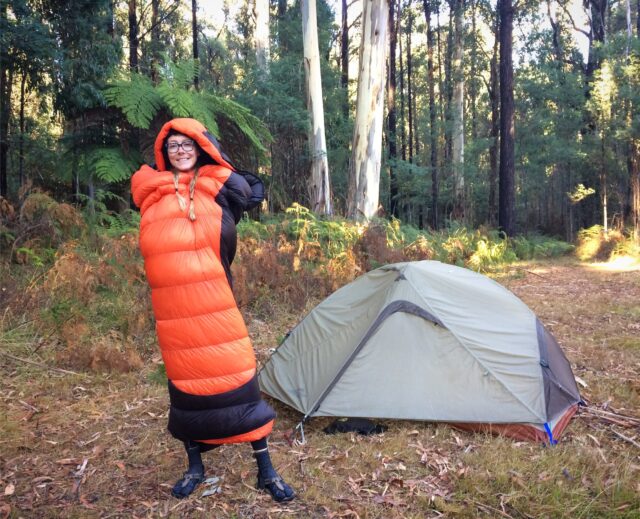
Where can people find you?
Instagram:
Pepper Cook – bookbikebrew
Worldwide Spoon Exchange – spoonoutside
Salsa Bikes – Pepper Cook
Our No Compromise Clause: We carefully screen all contributors to make sure they are independent and impartial. We never have and never will accept advertorial, and we do not allow advertising to influence our product or destination reviews.


